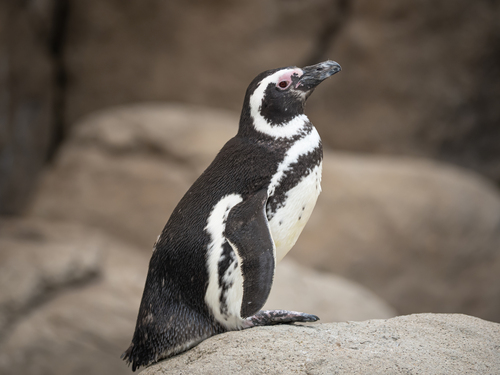
Magellanic Penguin
The Magellanic Penguin (*Spheniscus magellanicus*) is a South American penguin species known for its distinctive black and white plumage and unique breeding behaviors. It plays a crucial role in the marine ecosystems of the Patagonian Shelf and serves as an indicator species for the health of these waters. While not currently endangered, it faces significant threats from climate change, overfishing, and oil pollution. Culturally, the Magellanic Penguin is an iconic symbol of Patagonia, often featured in tourism campaigns and local artwork.
60-75 cm
Length
Not applicable (wings modified into flippers) cm
Wingspan
Near Threatened
Conservation Status
Distribution
Breeds on the coasts of Argentina, Chile, and the Falkland Islands. Migrates north along the coasts of South America, reaching as far as southern Brazil in the Atlantic and central Peru in the Pacific during the non-breeding season. Altitudinal range is generally limited to coastal areas.
Lifespan
Up to 25 years in the wild, potentially longer in captivity.
Magellanic Penguin's Habitat
Habitat Types
Coastal cliffs, Sandy beaches, Rocky shores, Burrows in soft soil or guano deposits
Climate Zones
Temperate, Subantarctic
Adaptations
Dense, waterproof plumage for insulation in cold waters. Streamlined body and powerful flippers for efficient swimming and diving. Salt glands above the eyes excrete excess salt.
Variations
No recognized subspecies, but some variations in size and vocalizations have been observed between different colonies.
Appearance
Breeding Plumage
Plumage is similar year-round, but may become slightly duller and browner outside of the breeding season due to wear and tear.
Seasonal Feather Changes
Undergoes a complete molt annually after breeding, replacing all feathers.
Sex Based Plumage Differences
Limited sexual dimorphism. Males may have slightly broader black bands on the head and chest.
Notable Features
Two black bands between the head and chest, White border around the black head, Pinkish skin around the eyes and base of the bill, Black, powerful bill
Diet and Feeding
Primary Foods
Small fish (anchovies, sardines, sprats), Squid, Crustaceans (krill, amphipods)
Foraging Behavior
Pursuit-diving, often foraging in groups. Can dive to depths of up to 75 meters, but typically feeds in shallower waters (20-50 meters).
Specializations
Streamlined body and powerful flippers allow for efficient underwater pursuit of prey. Rear-facing spines on the tongue help grip slippery prey.
Seasonal Diet Variations
Diet composition varies depending on prey availability, which can fluctuate seasonally and geographically. During migration, they may rely more on crustaceans.
Behavior
Social Structure
Highly social, breeding in large colonies that can number in the tens or hundreds of thousands. Forms smaller groups during migration and foraging.
Communication
Loud, braying calls (often described as donkey-like), Visual displays (head-shaking, flipper-waving), Mutual preening
Migration
Migrates north after breeding, following food sources. Migration routes are extensive, covering thousands of kilometers.
Territorial or Group Behaviors
Territorial around the nest site during breeding. Forages cooperatively at sea, sometimes forming large rafts.
Conservation
Threats
Oil pollution (chronic and acute spills), Overfishing of prey species, Climate change (affecting prey distribution and breeding success), Plastic pollution (ingestion and entanglement), Habitat degradation (coastal development)
Protection Programs
Marine Protected Areas (MPAs) in some breeding and foraging areas, International agreements on oil spill prevention and response, Monitoring programs to track population trends and threats
Local National Laws
Protected under national legislation in Argentina, Chile, and the Falkland Islands.
Population Trend
Decreasing
Population Estimates
Estimated at 1.1 to 1.6 million breeding pairs globally, but with significant declines observed in some regions.
Interesting Facts
They are named after Ferdinand Magellan
The explorer's crew sighted these penguins during their first circumnavigation of the globe in 1520.
They can drink saltwater
Specialized salt glands above their eyes allow them to excrete excess salt, enabling them to survive without access to freshwater.
They can hold their breath for several minutes
This allows them to dive deep and pursue prey underwater.
They are excellent swimmers
Reaching speed up to 24km/h.
Faqs about Magellanic Penguin
Are Magellanic Penguins endangered?
They are currently classified as Near Threatened by the IUCN, meaning they are not immediately endangered but face significant threats that could lead to endangerment in the future.
Where can I see Magellanic Penguins?
They can be seen along the coasts of Argentina, Chile, and the Falkland Islands, particularly during the breeding season (September-February). Several tour operators offer penguin-watching excursions.
What do Magellanic Penguins eat?
They primarily eat small fish, squid, and crustaceans, which they catch by diving underwater.
How do they survive in cold water?
Magellanic penguins have dense, waterproof feathers and a layer of blubber that provide excellent insulation against the cold.
Copyright @ Nature Style Limited. All Rights Reserved.
 English
English